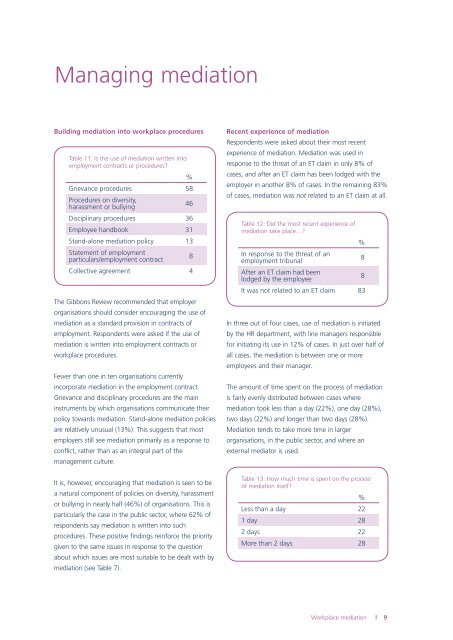Workplace mediation How employers do it - CIPD
Workplace mediation How employers do it - CIPD
Workplace mediation How employers do it - CIPD
You also want an ePaper? Increase the reach of your titles
YUMPU automatically turns print PDFs into web optimized ePapers that Google loves.
Managing <strong>mediation</strong>Building <strong>mediation</strong> into workplace proceduresTable 11: Is the use of <strong>mediation</strong> wr<strong>it</strong>ten intoemployment contracts or procedures?%Grievance procedures 58Procedures on divers<strong>it</strong>y,harassment or bullying46Disciplinary procedures 36Employee handbook 31Stand-alone <strong>mediation</strong> policy 13Statement of employmentparticulars/employment contract8Collective agreement 4The Gibbons Review recommended that employerorganisations should consider encouraging the use of<strong>mediation</strong> as a standard provision in contracts ofemployment. Respondents were asked if the use of<strong>mediation</strong> is wr<strong>it</strong>ten into employment contracts orworkplace procedures.Fewer than one in ten organisations currentlyincorporate <strong>mediation</strong> in the employment contract.Grievance and disciplinary procedures are the maininstruments by which organisations communicate theirpolicy towards <strong>mediation</strong>. Stand-alone <strong>mediation</strong> policiesare relatively unusual (13%). This suggests that most<strong>employers</strong> still see <strong>mediation</strong> primarily as a response toconflict, rather than as an integral part of themanagement culture.It is, however, encouraging that <strong>mediation</strong> is seen to bea natural component of policies on divers<strong>it</strong>y, harassmentor bullying in nearly half (46%) of organisations. This isparticularly the case in the public sector, where 62% ofrespondents say <strong>mediation</strong> is wr<strong>it</strong>ten into suchprocedures. These pos<strong>it</strong>ive findings reinforce the prior<strong>it</strong>ygiven to the same issues in response to the questionabout which issues are most su<strong>it</strong>able to be dealt w<strong>it</strong>h by<strong>mediation</strong> (see Table 7).Recent experience of <strong>mediation</strong>Respondents were asked about their most recentexperience of <strong>mediation</strong>. Mediation was used inresponse to the threat of an ET claim in only 8% ofcases, and after an ET claim has been lodged w<strong>it</strong>h theemployer in another 8% of cases. In the remaining 83%of cases, <strong>mediation</strong> was not related to an ET claim at all.Table 12: Did the most recent experience of <strong>mediation</strong> take place…? %In response to the threat of anemployment tribunal8After an ET claim had been lodged by the employee8It was not related to an ET claim 83In three out of four cases, use of <strong>mediation</strong> is in<strong>it</strong>iatedby the HR department, w<strong>it</strong>h line managers responsiblefor in<strong>it</strong>iating <strong>it</strong>s use in 12% of cases. In just over half ofall cases, the <strong>mediation</strong> is between one or moreemployees and their manager.The amount of time spent on the process of <strong>mediation</strong>is fairly evenly distributed between cases where<strong>mediation</strong> took less than a day (22%), one day (28%),two days (22%) and longer than two days (28%).Mediation tends to take more time in largerorganisations, in the public sector, and where anexternal mediator is used.Table 13: <strong>How</strong> much time is spent on the processof <strong>mediation</strong> <strong>it</strong>self?%Less than a day 221 day 282 days 22More than 2 days 28<strong>Workplace</strong> <strong>mediation</strong> 9

















